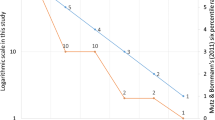Abstract
Journal impact factors (JIF) are computed by Thomson Reuters to three decimal places. Some authors have cast doubt on the validity of the third decimal place in JIFs. In this paper I present a new approach to evaluate the significance of decimal places in JIFs. To do so, two modified JIFs were computed by adding or removing one citation to the number used by Thomson Reuters to compute the JIF for journals listed in the 2008 Journal Citation Report. The rationale is that one citation is the minimum amount of impact that can be observed and analyzed. Next, the modified JIFs were compared with the original JIF to identify the decimal place that changed as consequence of adding or removing one citation. The results suggest that for about two-third of journals, the number of places used by Thomson Reuters to compute JIFs can be considered appropriate for the most part.


Similar content being viewed by others
References
Archambault, E., & Larivière, V. (2009). History of the journal impact factor: Contingencies and consequences. Scientometrics, 79, 635–649.
Bagatin, E., & Gontijo, B. (2011). The expansion of a measure: what is a scientific journal impact factor and how important is it for academic Brazilian dermatologists. International Journal of Dermatology, 50, 1432–1434.
Bar-Ilan, J. (2012). Journal report card. Scientometrics, 92, 249–260.
Bensman, S. J. (2007). Garfield and the impact factor. Annual Review of Information Science and Technology, 41, 93–155.
Braun, T. (2007). The impact factor of scientific and scholarly journals: Its use and misuse in research evaluation. Budapest: Akadémiai Kiadó.
Campanario, J. M. (2012). Some research ideas on journal impact factors as a crucial topic in science dynamics. Scientometrics, 92, 293–295.
Campanario, J. M. (2013). The effect of additional citations on the stability of journal citation reports categories. Scientometrics,. doi:10.1007/s11192-013-1116-3.
Garfield, E. (2006). The history and meaning of the journal impact factor. Journal of the American Medical Association, 295, 90–93.
Glänzel, W., & Moed, H. F. (2002). Journal impact measures in bibliometric research. Scientometrics, 53, 171–193.
Golubic, R., Rudes, M., Kovacic, N., Marusic, M., & Marusic, A. (2008). Calculating impact factor: How bibliographical classification of journal items affects the impact factor of large and small journals. Science and Engineering Ethics, 14, 41–49.
Greenwood, D. C. (2007). Reliability of journal impact factor rankings. BMC Medical Research Methodology, 7, 48.
Kumar, V., Upadhyay, S., & Medhi, B. (2009). Impact of the impact factor in biomedical research: Its use and misuse. Singapore Medical Journal, 50, 752–755.
Monastersky, R. (2005). The number that’s devouring science. The Chronicle of Higher Education, 52, A12.
Mutz, R., & Daniel, H. D. (2012). The generalized propensity score methodology for estimating unbiased journal impact factors. Scientometrics, 92, 377–390.
Neuberger, J., & Counsell, C. (2002). Impact factors: Uses and abuses. European Journal of Gastroenterology and Hepatology, 14, 209–211.
Pudovkin, A. and Garfield, E. (2004). Rank-normalized impact factor: A way to compare journal performance across subject categories. Proceedings of the 67th ASIS&T Annual Meeting, 41, 507–515.
Pudovkin, A., & Garfield, E. (2012). Rank normalization of impact factors will resolve Vanclay’s dilemma with TRIF. Comments on the paper by Jerome Vanclay. Scientometrics, 92, 409–412.
Retzer, V., & Jurasinski, G. (2009). Towards objectivity in research evaluation using bibliometric indicators: A protocol for incorporating complexity. Basic and Applied Ecology, 10, 393–400.
Ruiz-Perez, R., Delgado, E., & Jimenez-Contreras, E. (2010). Principios y criterios utilizados en España por la Comisión Nacional Evaluadora de la Actividad Investigadora (CNEAI) para la valoración de las publicaciones científicas: 1989–2009. Psicothema, 22, 898–908.
Sevinc, A. (2004). Manipulating impact factor: an unethical issue or An Editor’s choice? Swiss Medical Weekly, 134, 410.
Shao, J., & Shen, H. (2011). The outflow of academic papers from China: Why is it happening and can it be stemmed? Learned Publishing, 24, 95–97.
Smith, R. (1997). Journal accused of manipulating impact factor. British Medical Journal, 314, 461.
Sombatsompop, N., & Markpin, T. (2005). Making an equality of ISI Impact factors for different subject fields. Journal of the American Society for Information Science and Technology, 56, 676–683.
Vanclay, J. K. (2012). Impact factor: Outdated artefact or stepping-stone to journal certification? Scientometrics, 92, 211–238.
Vinkler, P. (2013). Would it be possible to increase the Hirsch-index, π-index or CDS-index by increasing the number of publications or citations only by unity? Journal of Informetrics, 7, 72–83.
Yu, G., & Wang, L. (2007). The self-cited rate of scientific journals and the manipulation of their impact factors. Scientometrics, 73, 321–330.
Zitt, M. (2012). The journal impact factor: angel, devil, or scapegoat? A comment on J.K. Vanclay’s article 2011. Scientometrics, 92, 485–503.
Acknowledgments
I thank K. Shashok for improving the use of English in the manuscript and for suggestions about the content. I thank also two anonymous referees for their suggestions.
Author information
Authors and Affiliations
Corresponding author
Rights and permissions
About this article
Cite this article
Campanario, J.M. The effect of citations on the significance of decimal places in the computation of journal impact factors. Scientometrics 99, 289–298 (2014). https://doi.org/10.1007/s11192-013-1206-2
Received:
Published:
Issue Date:
DOI: https://doi.org/10.1007/s11192-013-1206-2




